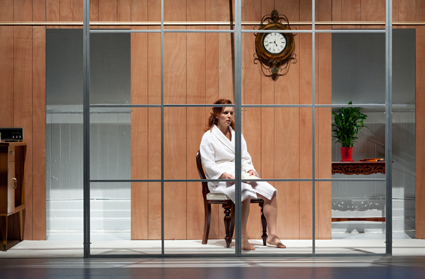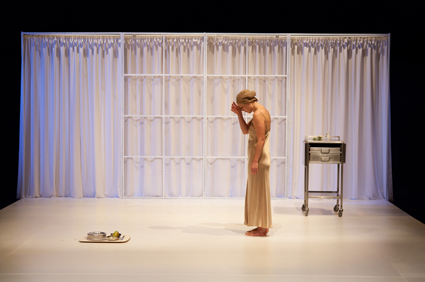bergman’s persona re-personified
andrew fuhrmann: fraught outfit’s persona

Meredith Penman, Persona
photo Pia Johnson
Meredith Penman, Persona
A BOY OF ABOUT EIGHT OR NINE CAUTIOUSLY MAKES HIS WAY ACROSS THE EMPTY STAGE. HIS MOVEMENTS HAVE THAT COY SELF-CONSCIOUSNESS PECULIAR TO CHILDREN. HE HAS A HEALTHFUL COMPLEXION AND A HAPPY IF SOMEWHAT MISCHIEVOUS AIR, A CONTRAST TO THE ESSENTIAL WHITE CURTAINS AND WHITE FLOOR OF THE SET. AFTER SITTING DOWN AND READING A BOOK IN SILENCE FOR A FEW MOMENTS, HE BRIEFLY EXAMINES THE AUDIENCE THROUGH A PAIR OF BINOCULARS, THEN LEAVES.
Although director Adena Jacobs makes no attempt to find a stage analogue for the rest of Bergman’s modernist cinematic montage, the famous visual poem that opens Persona (1966), she has nonetheless retained this strange prelude figure, the child-psychopomp, who in both the film and this current adaptation leads the audience from its present reality into the next.
Between stage and screen, however, the nature of that next reality must be radically different, and it is the way this difference is articulated by Fraught Outfit, Jacob’s company, that accounts for so much of the remarkable power in this unlikely adaptation.
Elisabet Vogler (Meredith Penman), a well-known stage actress, suddenly falls silent during her performance in the title role of Sophocles’ Electra. Although she eventually continues the performance, the next day she refuses to speak at all. The head doctor at the hospital where she is admitted for psychiatric treatment—in this production a disembodied voiceover (Jane Montgomery Griffiths)—suggests that Elisabet spend some time at an isolated seaside cottage with one of the hospital nurses, Alma (Karen Sibbing), where the doctor thinks she might rediscover the will to communicate. Although Elisabet seems immediately to relax in the cottage, she remains silent. Alma has a naturally lively personality and responds to her patient’s silence with a steady stream of small talk. As Elisabet’s silence seems to deepen, so too Alma’s conversation becomes more personal. When Alma reads a letter written by Elisabet to the head doctor in which she makes light of Alma’s revelations, it becomes too much for the nurse, leading to an intense series of psychic encounters between the two.
Although there is a tradition of producing Bergman’s films for the stage that goes back almost 50 years, and notwithstanding a recent vogue for adaptations of his more affectedly cerebral films, Persona represents an outrageous challenge for theatre makers. So much of its popular significance—its very status as a masterpiece—depends on the medium in which it was produced. It is self-reflexive to the point of incoherence, consistently disrupting narrative clarity and sabotaging authoritative communication by exposing the processes and materials of its own construction. In the words of Bergman, whose own preferred title for the film was Cinematography:
“Today I feel that in Persona—and later in Cries and Whispers—I had gone as far as I could go. And that in these two instances when working in total freedom, I touched wordless secrets that only the cinema can discover.”

Meredith Penman, Persona
photo Pia Johnson
Meredith Penman, Persona
There is an engrossing and enduring ambiguity in this well-known quotation. He “had gone as far as he could” toward what? The mystery of this question lies in the face—the face as both the principal motif of Bergman’s film and the medium of film itself, the “black hole and white wall, screen and camera.” What Bergman touches on is the truth about the face, and also about cinema: its mesmeric inhumanity and the regime of deception it enforces.
Or, rather, he touches on the ineffable implication of that truth—that peculiar feeling of revulsion at seeing Alma’s and Elisabet’s faces merge at the film’s climax, for example.
“The inhuman in human beings: that is what the face is from the start. It is by nature a close-up, with its inanimate white surfaces, its shining black holes, its emptiness and boredom. Bunker-face. To the point that if human beings have a destiny, it is rather to escape the face, to dismantle the face and facialisation.” (Deleuze and Guattari, A Thousand Plateaus, 1980)
In order to escape the cinema-face and rise above a mere capitulation of doubtful events, Persona must be de-faced for the stage. It must discover, to use the vocabulary of Deleuze and Guattari, quoted above, the ancient “volume-cavity system” of the theatre, or the theatre-body.
At the very back of the deeply set stage, some 10 to 15 metres from the audience, we see the interior of a single room in the head doctor’s holiday cottage. A white curtain can be drawn across this facade, while another is used occasionally to shorten the stage and bring the action forward. This doesn’t so much reproduce the various camera shots, close-up and landscape, as emphasise the divisibility of the shared space.
The extensive use of curtains also suggests that we are all sharing a single chamber, performers and audience, while also underlining the theatrical tradition into which the story has been imported. As the size of the chamber changes, so too does our sense of intimacy with the performers and their secret magnetism. Indeed, intimacy, or the attempt to discover a sense of intimacy that goes behind the face, becomes the thematic core of this adaptation, displacing Bergman’s obsession with the fragility of self-constructed identity.
The effect of this displacement is clear, for example, in the scene where Elisabet’s husband (Daniel Schlusser) mistakes Alma for his wife. Bergman’s tragic eroticism, the hypnotic layering of the three faces, becomes a comic, though still poignant, collision of bodies, an awkward striving to get past the misapprehension of the face. It is this clumsy honesty of bodies that distinguishes Fraught Outfit’s involving dramaturgy, revealing something that Bergman’s faces, sliding gracefully across and into the landscape, otherwise obscure, something typified by Karen Sibbing, for example, as she appears in the latter half of the production, distraught, a chunky bandage on her hand, hair dishevelled and in every way miserably present.
In contrast with other recent Bergman adaptations, including both Jenny Worton’s Through a Glass Darkly (Almeida Theatre, 2010) and Simon Stone and Andrew Upton’s Face to Face (STC, 2012), Jacobs resists the allure of Bergman’s “juicy dream” dramaturgy. When we are at last released from the drama, it is not the enchanted island of Bergman’s Faro that we leave, with its population of demon hypnotists and Strindbergian somnambulists, but the firm, multi-dimensional embrace of the theatre-body. Thus, where Bergman’s film is fundamentally a critique—a demonic critique—of art, artists and civilised life in general, Fraught Outfit’s adaptation is essentially a more positive exercise, an attempt to generate the conditions of intimacy and even perhaps community.
See an interview with Simon Stone about his adaptation of Face to Face (RT110) and the review of the production (RT111).
Fraught Outfit, Persona, from the film by Ingmar Bergman, translator Keith Bradfield, conceived and adapted by Adena Jacobs, Dayna Morrissey, Danny Pettingill, director Adena Jacobs, performers Meredith Penman, Daniel Schlusser, Karen Sibbing; Theatre Works, Melbourne May 18-27, 2012; Belvoir, July 24-Aug 8, 2013
RealTime issue #112 Dec-Jan 2012 pg. 30






